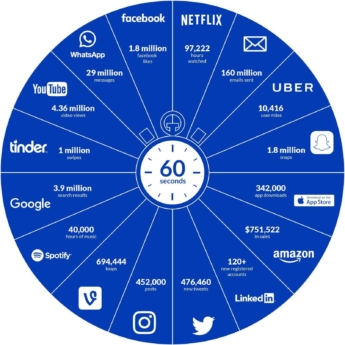24 October 2019
In an effort to generate sales, we are all faced with the ever increasing difficulties of reaching the right contacts through ‘traditional’ email marketing, with more and more sophisticated spam filters and audience blindness to email overload!
Then there are cold calls….always a tough one for any sales team to employ effectively and worth questioning whether it is actually the best use of their time? With only 1% of cold calls actually resulting in appointments and 90% of B2B decision makers not responding to cold sales outreach, that suggests your business might need to consider other avenues when it comes to generating more sales – so could one of these be social selling?
With the growth in Big Data, social selling has become a powerful strategy that can help sell ideas, establish credibility and win customers. According to Hootsuite, 78% of sales people who are actively engaged in social selling are outselling their peers who are not using this approach. In addition, 31% of B2B professionals have said that social selling has allowed them to build deeper relationships with their clients.
Both of these points help to illustrate the importance of social selling as a sales channel that could bring some real benefits to your business.
What is the difference between social selling and social media marketing?
When it comes to social selling make sure you don’t mistake it for social media marketing!
Social media marketing is all about gaining traffic and attention for your business, through social media sites such as Twitter and Facebook – marketing your company’s products and services to both potential prospects and your existing customers.
Whereas, social selling is all about forming and building relationships with your audience through social networks to discover, connect, listen, understand and nurture your sales prospects.

When using social media to market your company, your business activity will go some way to dictate which social channels are most suitable as a way to build your brand, for example: if you are an online fashion retailer, Instagram would be the ideal channel to use, giving you the ability to showcase your items visually through images and videos.
Whereas, LinkedIn and Twitter have a better success rate for B2B industries, potentially offering a better lead generation performance. Whilst of course Facebook has the biggest user demographic, it’s perhaps not always the best platform for B2B business, tending to be more focused on personal use.
However when it comes to social selling, to gain traction with potential customers, you will need to identify the social sites they are then using and where they spend their time!
But have you got the time?
With 20% of a sales person’s time dedicated to searching and collecting information, the majority of sales people often feel overwhelmed by the amount of data and the time it takes for them investigate and follow up potential leads.

The wealth of information available on the internet and social networks is undeniable, the problem is, in an effort to build your social selling strategy, how and where do you find out what you need to know about your potential customers? Monitoring this data will be time-consuming and is undoubtedly a big challenge for any business and their sales people to manage.
Then what will you do with this information once you have gathered it? – How can you turn this data into something meaningful that your sales team can act upon?
To get you started…here are our top 3 tips when it comes to social selling…
#1 Discover
As we have seen there are so many different social media channels, but for anyone new to the process of social selling, it can be somewhat overwhelming.
However one way to gather information is to use a business sales intelligence tool such as ByPath or LinkedIn Navigator or DiscoverOrg – these can be a real asset when it comes to finding the right information and then helping you deal with all this data.
Sales intelligence software is designed to help companies use data to increase sales and improve sales processes with a view to improving the quality and quantity of leads. Their purpose is to find new opportunities and give sales people the data they need to take advantage of them.
ByPath for example analyses Big Data found across the internet from multiple sources across social networks, twitter, blogs and from thousands of media sources, as well as the global B2B Kompass database to provide sales teams with insightful alerts they can share and action.
#2 Connect
Once you have selected your ideal social networks that your potential prospects inhabit, you need to find and connect with the right people. Social selling and gathering sales intelligence is all about building relationships, remember you are selling to people, not just a company, so gaining access to key information that can help develop those relationships is essential.
Twitter allows you to create lists made up of different categories; the best categories to create lists are for your prospects, customers and your ideal/dream prospects. By creating these lists it allows you to see all postings from these people or companies and allows you to engage with them where appropriate.
LinkedIn has a group feature which allows you to join in discussions for a given topic. For example, as a marketer by joining social media and marketing groups, you can view and join in with discussions that are relevant. Through this you can find people who may be good to connect with and people who may be potential prospects for your business.
In order to make sure you concentrate your efforts on the right prospects at the right time, ByPath helps you follow companies and contacts so that any newly discovered information found online will flag up as an alert, for example: a potential lead, an article mention, a relevant tweet or a change in job role.
All of these actions can be helpful as you build your social selling strategy – giving you the opportunity to learn more about individuals and through this build deeper relationships with both potential prospects and existing customers.
#3 Nurture
Connecting with people and listening to what they are saying to understand their wants and needs is vital to social selling. It is important that you don’t bombard them with product posts or information that is just about your company. Don’t just sell, sell, sell!
Ideally you should engage with your potential prospects and existing customers by sharing content that is relevant to them – then ask for feedback to discover what they do and don’t like. This can lead to potential sales, but the key thing here is to build positive relationships first, otherwise they may not be open to or interested in what you have to say.
Gaining reliable customers that trust in you and your business can often lead to recommendations to others through content sharing and referrals. 31% of B2B professionals have said that social selling has allowed them to build deeper relationships with their clients and 74% of consumers have identified word-of-mouth as a key influencer in their purchasing decision – these statistics are certainly hard to ignore.
As an effective sales channel, social selling is valuable to any business; you just need to plan your strategy and remember it’s not just about selling your products or services but engaging with your prospects, building a good relationship and addressing their needs.
Chloe Rowe – Marketing Assistant – Castelli Ltd
Disclaimer: Please note that this blog only contains general information and insights about legal matters. The information is not advice, and should not be treated as such. Kompass.com







Comentarios
No Comments